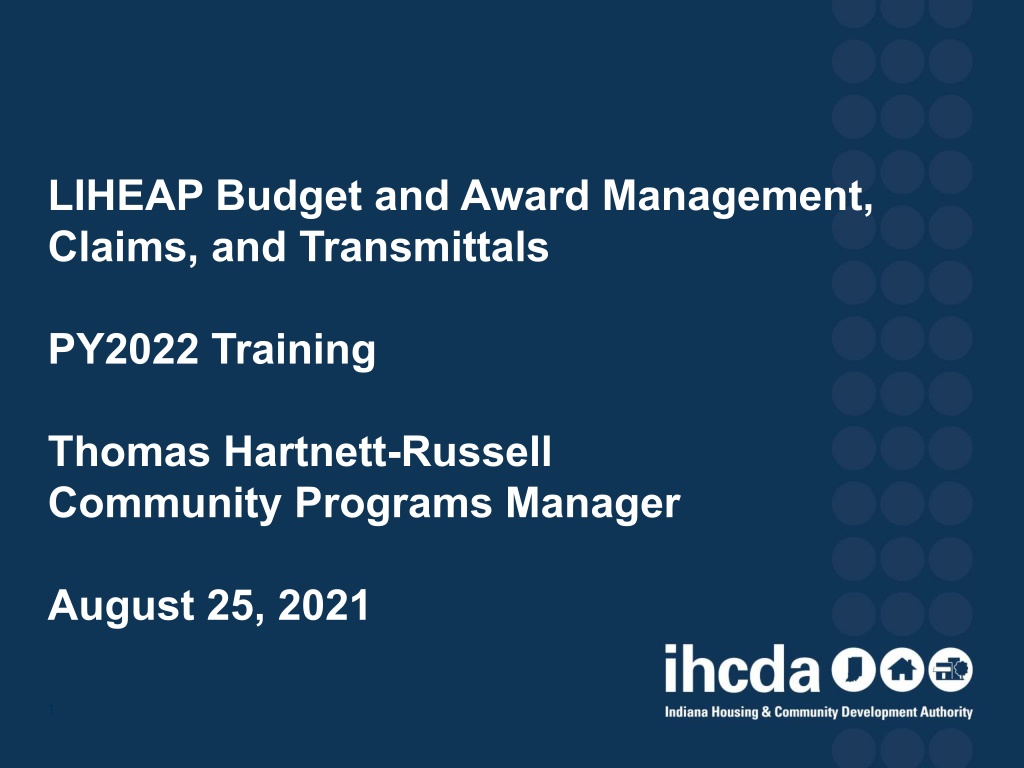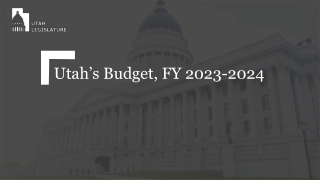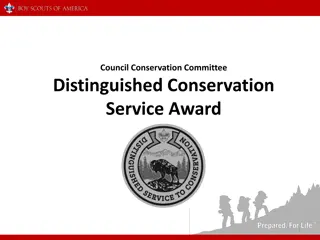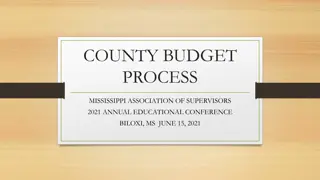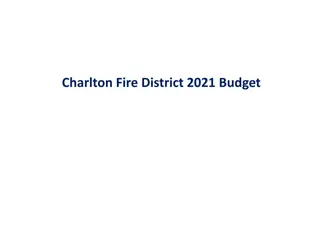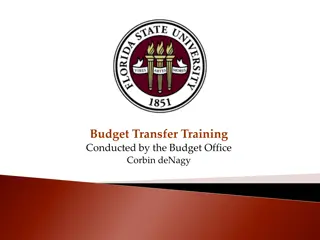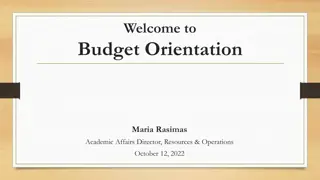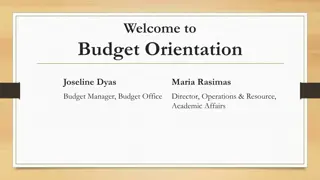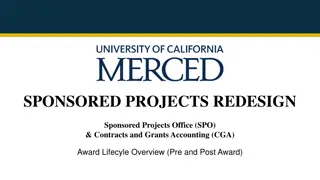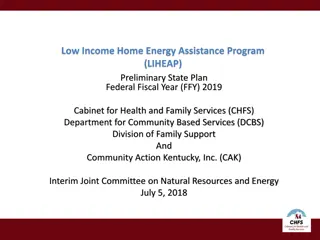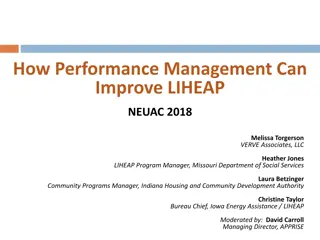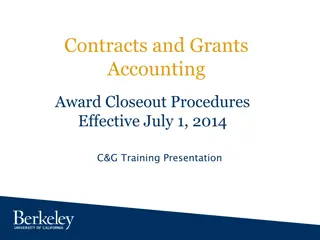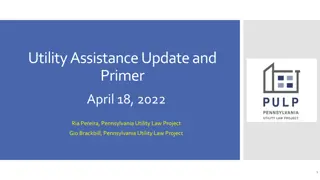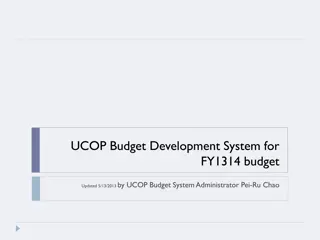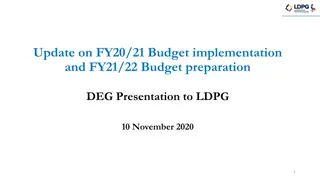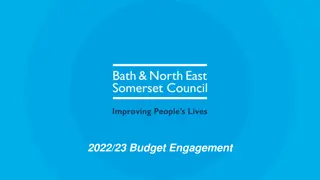LIHEAP Budget and Award Management Training Overview
This overview covers key aspects of LIHEAP budget management, including line items for budgeting awards, administrative expenses, outreach, and eligibility determination. It emphasizes the importance of understanding and effectively utilizing budget allocations to ensure program efficiency and compliance with funding regulations.
Download Presentation

Please find below an Image/Link to download the presentation.
The content on the website is provided AS IS for your information and personal use only. It may not be sold, licensed, or shared on other websites without obtaining consent from the author. Download presentation by click this link. If you encounter any issues during the download, it is possible that the publisher has removed the file from their server.
E N D
Presentation Transcript
LIHEAP Budget and Award Management, Claims, and Transmittals PY2022 Training Thomas Hartnett-Russell Community Programs Manager August 25, 2021 1
BUDGET OVERVIEW LSPs have seven line items to which they can budget their awards. Administrative Expenses Outreach and Eligibility Determination Assurance 16 Regular Benefits Crisis Benefits Emergency Repair and Replacement Emergency Services 2
ADMINISTRATIVE EXPENSES The Administrative Expenses line item can be used to cover overall administration and operation of the program. Administrative Expenses can include, but are not limited to: EAP administrative functions, including program planning, staff training, reporting, and any allocated costs such as rent, utilities, maintenance, and general supplies. EAP service delivery functions, including fiscal, executive, supervisory, and support operations. This may include agency salary allocations. Any expense that is otherwise eligible to be paid using Outreach and Eligibility Determination. 3
ADMINISTRATIVE EXPENSES LSPs may budget up to 7.5% of their total expenditures to Administrative Expenses. Administrative Expenses may not be supplemented with any other federal funds. Because the 7.5% maximum is based on expenditures and not initial award, LSPs may need to pay back a portion if they max out their Administrative Expenses line but underspend on their overall budget. It is important, therefore, that EAP supervisory staff and agency fiscal staff are regularly communicating and checking in to ensure that obligations are more or less in line with administrative claims. 4
OUTREACH AND ELIGIBILITY DETERMINATION Outreach and Eligibility Determination is a renaming of Direct Program Expenses, a new budget line item introduced during PY2021. Allowable Outreach and Eligibility Determination expenses are defined as costs that are specific to delivery of EAP and do not otherwise contribute to the overall operations of the agency, nor to any other program. Indirect or allocated costs may not be charged to Outreach and Eligibility Determination; nor may payroll for management, executive, or supervisory staff, even if a manager or supervisor only oversees EAP. All such expenses must be charged to Administrative Expenses or paid from unrestricted funds. 5
OUTREACH AND ELIGIBILITY DETERMINATION Examples of allowable Outreach and Eligibility Determination charges include: Salaries/payroll for line-level intake staff Supplies needed by intake staff in order to determine eligibility and will not be used for any other purpose in the agency Client outreach initiatives Technology needs that will only be utilized by EAP staff in eligibility determination, intake, or outreach 6
OUTREACH AND ELIGIBILITY DETERMINATION Examples of unallowable Outreach and Eligibility Determination charges include: Salaries/payroll for management, executive, or supervisory staff, whether direct salary or spread Indirect or allocated costs Rent or utilities, even if for a satellite location that only engages in EAP operations. Payroll for management, executive, supervisory, or agency clerical/support staff may not be charged to Outreach and Eligibility Determination, even if a manager or supervisor only oversees EAP. All such expenses must be charged to Administrative Expenses or paid from unrestricted funds. 7
OUTREACH AND ELIGIBILITY DETERMINATION Outreach and Eligibility Determination is limited to a cap of 4.5% of an LSP s EAP award. The 4.5% is based on award and not expenditures, so no payback will be needed if the LSP underspends on its overall budget. If an LSP exhausts its Outreach and Eligibility Determination line, these items may also be paid for out of the Administrative Expenses line. 8
ASSURANCE 16 Assurance 16 refers to the optional 16th Assurance of the federal LIHEAP statute. This Assurance allows grantees to set aside a maximum of 5% of its award to engage in services and activities that are designed to reduce clients household energy needs, and thereby reduce the need for energy assistance. In Indiana, authorized Assurance 16 activities include energy education programs, direct case management services aimed at increasing self-sufficiency, and referral and advocacy activities that will reasonably be expected to contribute toward reducing household energy need and enabling energy security. 9
ASSURANCE 16 Allowable Assurance 16 activities/charges include: Needs assessment counseling Energy Education workshops Family development casework Assisting client households in negotiating payment agreements Providing kits that supply eligible households with supplies that help reduce energy usage (e.g., LED light bulbs, faucet aerators, etc.) 10
ASSURANCE 16 Unallowable expenses for charging against Assurance 16 include: Staff PTO Allocated salary spreads Eligibility determination or client outreach Executive salaries Client outreach Rent and utilities 11
ASSURANCE 16 LSPs may budget up to 5% of their total award to Assurance 16 activities. The 5% maximum applies to the LSP s total award, not just to obligations/expenditures. 12
REGULAR AND CRISIS BENEFITS Regular benefits are awarded based on matrix points that are worth $25 each, plus a flat-rate $125 electric benefit. Crisis benefits are variable based on the exact amount needed for restoration or disconnection prevention. All LSPs are federally required to allocate at least 8% of their total award amount to Crisis Benefits through March 15th. 13
EMERGENCY BENEFITS LSPs may budget up to 10% of their total award to the two Emergency Benefits lines (Emergency Repair and Replace and Emergency Services). All LSPs are required to maintain funding in the Emergency Repair and Replace line item through March 15th. There is no requirement to maintain any funding in the Emergency Services line. The 10% maximum is based on total award, not on obligations/expenditures. After March 15th, LSPs are strongly encouraged to defund any remaining funds from these line items and reallocate them to Regular Benefits and/or crisis benefits. 14
LINE ITEMS REVIEW Line Item Maximum Percentage Calculation based on Eligibility/Admin 7.5% Obligations/ Expenditures Direct Program Expenses 4.5% Total Award Assurance 16 5% Total Award Emergency Services 10% total with Emergency Repair and Replace Total Award Emergency Repair and Replace 10% total with Emergency Services Total Award Regular Benefits None N/A Crisis Benefits None; minimum allocation of 8% through March 15th Total Award 15
AMENDMENTS Whenever IHCDA receives additional funding from HHS, it will put the funding through the allocation table and issue amendments to all active LSP subawards. Amendments may also be issued as a result of an involuntary deobligation of funding (e.g., due to an LSP not meeting benchmarks), a voluntary deobligation by an LSP, or due to an approved request for additional funding by the LSP (provided IHCDA has the funds available). LSPs are expected to issue a request for additional funding once it has obligated 90% of its benefit lines. Additional funding requests must be reviewed by the Community Programs team and approved by IHCDA s Executive Director before being granted. IHCDA reserves the right to partially approve a request. 16
AMENDMENTS Upon approval, Community Programs staff will issue the amendment. The amendment must be executed by the LSP Executive Director and IHCDA s Executive Director, and Community Programs must receive and approve a completed corresponding budget from the LSP, before the budget can be updated. Additional funding requests must meet the following requirements in order to be considered: Submitted on LSP letterhead Signed by the LSP s Executive Director Includes the following information: Estimated number of clients to be served, including summary of existing appointments scheduled and mail-in applications received Average benefit per client Estimated amount of funds to be used for Program Administration Total amount of funds requested Estimated length of time the requested funds would cover. 17
BUDGET MODIFICATIONS A budget modification may be submitted at any time without a corresponding amendment. Budget modifications must be signed by the LSP EAP Manager or a designee. Authorized designee lists should be submitted to IHCDA. Prior to executing budget modifications, Community Programs staff will review the request and ensure that all line items meet applicable requirements with regard to minimum or maximum amounts of allocation. If a budget modification is not signed, or does not meet policy requirements for any given line item, the budget modification will not be approved and Community Programs staff will request a new modification. 18
BEST PRACTICE SUGGESTIONS Monitor your obligations regularly. Consider monitoring them daily once you get close to 75% obligation on your benefit lines. Be proactive in thinking about requesting additional funds; remember that it takes some time to run requests through leadership and to draft and generate amendments. Consider how you might maximize your ability to completely obligate your funding. For instance, regular benefits should always be in multiples of $25. Therefore, if you have $750,002.49 allocated to your regular benefits line, then you will find yourself in a scenario where you will never be able to spend that down completely; you will always leave $2.49 on the table. After allocating your other lines, if you find you have an odd number in your regular benefits, consider rounding it down to a multiple of $25 and putting the excess into Crisis Benefits. 19
BEST PRACTICE SUGGESTIONS Be aware of timelines with your Emergency Benefits lines. Unless IHCDA issues additional guidance or grants a specific exception, Emergency Services and Emergency Repair and Replace may only be administered through March 15. If you keep funds in these lines after March 15, these funds are essentially unusable and will prevent you from reaching peak efficiency in your administration of the funds, and may impact your Administrative Expenses cap. IHCDA strongly recommends submitting a budget modification to move all excess funds out of these line items and into Regular Benefits and/or Crisis Benefits after March 15. 20
BEST PRACTICE SUGGESTIONS Look at your LSP s track record on obligations. Take a hard look at your LSP s history the past few years with regard to how closely you have been able to spend your entire obligation. If you find that you have consistently not expended your entire award, you may want to consider taking that into account when determining your Administrative Expenses allocation. Remember, that line item is based on total expenditures rather than award, and if you underspend your award but max out your Administrative Expenses line, you may need to pay back a portion. 21
BEST PRACTICE SUGGESTIONS Communicate regularly with your fiscal team. Be sure that your fiscal team has access to the EAP Policies and Procedures manuals and understand the requirements. Compare your obligation percentages for your Administrative Expenses to your overall obligations. Make sure that the fiscal team and EAP management team are aware of the trends with regard to applications and obligations. IHCDA suggests that you may want to share this training with your fiscal team as well. Let us know if future trainings with a finer focus on fiscal issues would be helpful. We want to hear from you! We would love to be able to share other best practices that we have not thought of in the future. Please send correspondence to liheap@ihcda.in.gov. 22
TRANSMITTALS Transmittals are the official written/electronic notification to the vendor that we are committing to send a specific amount to a vendor. Language in our MOA authorizes the vendor to accept the transmittal as being a binding agreement to pay, in spite of the fact that their MOA exists between them and IHCDA, and not with the subgrantee. This is why it is so important that any claims adjustments after a transmittal has been accepted are handled with the addition of positive or negative claims, rather than adjusting the existing claim. 23
TRANSMITTALS Transmittals consist of several components: 1. The transmittal report. 2. The transmittal signature sheet. 3. The Electronic Data Interchange (EDI), often referred to as electronic transmittal. 4. The Overpayment Remittance sheet, for transmittals that contain a negative claim. This must be sent to the vendor with any overpayment transmittals. 5. The Direct Payment Spreadsheet, for transmittals that contain direct payment claims only. 24
TRANSMITTALS Some agencies run transmittals completely through program staff, some completely through the fiscal office, and some have a collaborative process. Although the collaborative process is probably the most secure in terms of checks and balances on the obligation levels and the potential for both human error and fraud, waste, and abuse, there is nothing inherently wrong with the other two methods. Agencies who run transmittals solely out of their program office or solely out of their fiscal office, however, should be sure they have additional communications and corrective procedures in place, and that each part knows and understand the other s role in the process. 25
THE TRANSMITTAL PROCESS At least every other week, but preferably weekly at a minimum, open claims in EAPConnect are pulled into a transmittal. The transmittal is sorted by vendor and funding source. Each transmittal consist of a list of accounts, information about each account, the benefit amount being pledged for each account, a total number of pledges on the transmittal, and an aggregate total of pledged funding, as well as identifying information for the vendor and agency, and a transmittal number and batch number. The transmittal number is a 12-digit number that begins with 150000 (e.g., 150000364894), and is generated sequentially based on the number of transmittals that are created network-wide. The batch number is based on transmittal generated by any given LSP and varies by subgrantee. In general, batch numbers are useful for internal LSP use, while transmittal numbers are useful for communication with IHCDA and vendors. 26
THE TRANSMITTAL PROCESS The transmittal is sent to the vendor. Some agencies sign off on the transmittal prior to sending it to the vendor. More on the pros and cons of this later. Some agencies send the transmittal off blindly, while some review the transmittals first. More on the pros and cons of this later. In general, batch numbers are useful for internal LSP use, while transmittal numbers are useful for communication with IHCDA and vendors. 27
THE TRANSMITTAL PROCESS The vendor reviews and signs the transmittal, signaling acceptance. Note that the vendor is obligated by terms in the MOA to fully review the claims on the transmittal prior to executing the transmittal. The vendor must make corrections (e.g., correcting incorrectly-entered account numbers or incorrect billing names; flagging inactive or closed accounts for removal) and mark them on the transmittal. If any claims are flagged for removal, the vendor should also adjust the aggregate dollar amount of the transmittal. For vendors that use EDIs, this process is streamlined because their system will use the EDI to verify the accounts, and representatives only have to manually investigate the ones that are rejected. The vendor may send back the full transmittal report or just the signature sheet. If they only send the signature sheet, however, they still must communicate any corrections/changes/rejections to the LSP. 28
THE TRANSMITTAL PROCESS The LSP reviews and makes corrections in EAPConnect. All corrections or rejections/deletions noted on the transmittal must be made in EAPConnect. Failure to do so may lead to monitoring findings and could represent federal monitoring findings if pulled by HHS. It is not enough to know that the vendor is applying the benefit to the correct account, but we must also be able to demonstrate that. Furthermore, failure to remove a rejected claim will result in IHCDA overpaying the vendor, leading to waste of federal funds. These corrections must be made as promptly as possible, but within one calendar week at the latest. 29
THE TRANSMITTAL PROCESS Once corrections are made, the LSP submits the transmittal to IHCDA fiscal for payment through the EAPConnect interface. This must be done with seven calendar days of receipt of the accepted and/or corrected transmittal from the vendor. You will be issued a seven-digit claim receipt number. You can use this claim receipt number to check the status of a claim in IHCDAOnline. The claim receipt number is most useful for communicating with claims or accounting staff about the status of a claim. The internal steps for IHCDA are: claims review, accounting review, and ACH approval. Each step typically takes about a week. Therefore, a vendor will typically get paid about three weeks after you submit the transmittal to IHCDA fiscal. This is why the timeframes early on are so important. 30
SPECIAL TRANSMITTAL CONSIDERATIONS Transmittal generation, review, and management Are transmittals being grouped by funding program (regular vs. crisis)? Are transmittals generated by program or fiscal staff? Are you operating on a fixed, regular schedule for transmittals? Are transmittals being reviewed by program staff prior to being sent to vendors? (e.g., irregular amounts, missing account numbers, account numbers that do not match format). Do you have a tracking system set up for your transmittals? Do you follow up with vendors if you have not received a returned transmittal within a certain amount of time? 31
SPECIAL TRANSMITTAL CONSIDERATIONS To sign or not to sign? Several agencies pre-sign their transmittals upon generation, sometimes doing so electronically to save time and burden. Roeing is unveiling electronic signature to make it even easier and faster to pre-sign transmittals. An agency signature represents acceptance of the transmittal before the vendor has marked any corrections/rejections. Signing upon return from vendor can be a good way of documenting/tracking time frames for submitting accepted transmittal to fiscal. There is no right or wrong here it is up to agencies to have their own processes and to have any necessary contingencies. 32
SPECIAL TRANSMITTAL CONSIDERATIONS Making and Verifying Corrections Whose responsibility is it to make corrections? When making corrections marked by vendor, are you comparing the corrected information to information in the file? If corrected information does not match information in file, is somebody following up with vendor to clarify? If vendor indicates an account number or billing name has changed, are you requesting documentation of that information for the file? If claims are rejected, are you comparing the new total listed on the transmittal to the new total in the EAPConnect submission system? 33
SPECIAL TRANSMITTAL CONSIDERATIONS Collaboration between Program and Fiscal In order to be as successful as possible, Program staff and Fiscal staff should be in lockstep. By knowing what is going on in each other s world and the role each plays in the process, more informed discussions about issues such as realistic Administrative Expenses limits and proper billing of Assurance 16 can be had more productively. Program staff can always view full budget details, including pending claims, through IHCDAOnline if they have a login (view-only logins are available). 34
REIMBURSEMENT TRANSMITTALS Certain kinds of claims namely those for crisis biofuel payments made directly to the client by the agency, and for biofuel vendors who enter into an MOA relationship with the agency and the agency pays directly require special handling and additional steps. These claims are handled as regular third-party claims processed through the transmittal system since they are still ultimately benefits going to the client. However, since the agency has essentially fronted the value of these benefits, the agency is the actual payee and is reimbursed with this payment. As a check and balance, in order to process these claims correctly and demonstrate to any federal monitors that the benefits did ultimately go to the applicant and not to the agency, we will need additional documentation. 35
REIMBURSEMENT TRANSMITTALS All such claims shall be assigned to the vendor Biofuel [subgrantee name] within EAPConnect. Claims are processed through the transmittal system as usual. Depending on who processes and accepts transmittals in the agency, the vendor acceptance signature on the transmittal (for record-keeping purposes) should be either the EAP Manager, Fiscal Director, or Executive Director. The same person should not be signing as both agency representative and vendor representative. Take note of the claim receipt number EAPConnect gives you for your reimbursement transmittal claim you will need it to attach additional documentation. 36
REIMBURSEMENT TRANSMITTALS After submitting the claim for payment through EAPConnect, find the claim in IHCDAOnline using the claim receipt number and upload the appropriate documentation: For reimbursement of crisis paid to applicants, an itemized applicant list with benefit amounts (the transmittal report will suffice for this) as well as scans or electronic facsimiles of the checks. For reimbursement of voucher payments to a biofuel vendor, an itemized applicant list with benefit amounts (the transmittal report will suffice for this) as well as scans or electronic facsimiles of the corresponding executed vouchers and scans or electronic facsimiles of payments made to the biofuel vendor. It may facilitate this process if EAP staff and Fiscal staff can work out a procedure to create and store facsimiles of these checks and vouchers in a central location for purposes of attaching to claims. 37
